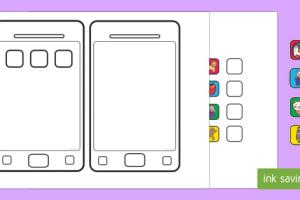Embrace Life Beyond the Screen: A Comprehensive Guide to Cutting Out Your Smartphone

-
Quick Links:
- Introduction
- Understanding the Need to Cut Out Your Smartphone
- Benefits of Disconnecting
- Step-by-Step Guide to Cutting Out Your Smartphone
- Alternatives to Smartphones
- Real-Life Experiences
- Expert Insights on Digital Detox
- Maintaining Your New Lifestyle
- FAQs
Introduction
In a world where our smartphones have become extensions of ourselves, the idea of cutting them out might sound daunting. Yet, as more individuals seek to reclaim their time and mental clarity, the movement toward a smartphone-free lifestyle is gaining momentum. This guide will explore not only the necessity behind this shift but also practical ways to enjoy life fully without the constant presence of a smartphone.
Understanding the Need to Cut Out Your Smartphone
Smartphones have transformed how we communicate, work, and entertain ourselves. However, this convenience often comes at a cost:
- Increased Anxiety: Constant notifications can lead to heightened anxiety levels.
- Decreased Productivity: The temptation to check social media or emails can disrupt focus.
- Social Isolation: Ironically, while we are more connected digitally, we may feel more isolated in real life.
Recognizing these effects is the first step towards making a change.
Benefits of Disconnecting
Cutting out your smartphone can lead to numerous benefits, including:
- Improved Mental Health: Less screen time often correlates with reduced stress and anxiety.
- Enhanced Relationships: More face-to-face interactions foster deeper connections.
- Increased Productivity: Fewer distractions allow for better focus on tasks.
Statistical data shows that individuals who engage in digital detox report 80% higher satisfaction in personal relationships and 70% improved mental clarity.
Step-by-Step Guide to Cutting Out Your Smartphone
Step 1: Assess Your Usage
Begin by tracking how much time you spend on your smartphone daily. Apps like Screen Time for iOS and Digital Wellbeing for Android can provide insights.
Step 2: Set Clear Goals
Decide how long you want to disconnect. Start with a weekend or even a week. Setting a clear timeline can make the process less overwhelming.
Step 3: Inform Others
Let friends and family know about your plan to disconnect. This way, they can support you and understand if you are less available.
Step 4: Find Alternatives
Replace smartphone activities with alternatives. For instance, read a physical book instead of scrolling through social media.
Step 5: Embrace New Hobbies
This is the perfect opportunity to explore new interests. Whether it's painting, hiking, or cooking, engage in activities that don’t require a screen.
Alternatives to Smartphones
Here are some alternatives to help you stay connected without a smartphone:
- Basic Cell Phones: Consider using a basic phone for calls and texts without apps.
- Smartwatches: Devices like the Apple Watch can help you stay connected without a smartphone.
- Tablets & Laptops: Use these devices at home for necessary communication and entertainment.
Real-Life Experiences
Many individuals have successfully cut out smartphones and reclaimed their lives. For example, a user named Sarah shared her journey:
"I used to spend hours scrolling through social media, but when I decided to cut out my smartphone, I found myself reading more books and spending time with my family. It was liberating!"
Expert Insights on Digital Detox
Experts in psychology suggest that taking breaks from technology is essential for mental well-being. Dr. Sherry Turkle, a psychologist and author, notes:
"Disconnecting allows us to reconnect with ourselves and others in a more meaningful way." (Source: TED Talk)
Maintaining Your New Lifestyle
Once you've successfully disconnected, here are tips to maintain your new lifestyle:
- Regularly assess your digital habits.
- Set specific times for technology use.
- Engage in community activities and events.
FAQs
1. What are the signs I need to cut back on my smartphone use?
If you find yourself feeling anxious when not using your phone or if you frequently check it during conversations, these are signs to consider cutting back.
2. Can I still use my smartphone for essential tasks?
Yes, many people choose to use basic phones or limit smartphone use to specific times for necessary tasks.
3. What are the best alternatives to social media?
Consider engaging more in-person with friends, joining clubs, or exploring new hobbies.
4. How long should I disconnect for?
Start with a weekend and gradually increase the time as you become comfortable.
5. Will my friends support my decision to disconnect?
Most friends will understand and may even support you by joining you in the process.
6. What if I feel bored without my smartphone?
Explore new hobbies, read books, or practice mindfulness to fill your time.
7. Is it possible to reconnect with technology after a detox?
Yes, many choose to reconnect but set stricter boundaries to avoid falling back into old habits.
8. How can I stay informed without a smartphone?
Use newspapers, magazines, or computer-based news sources to stay updated.
9. Can I still use apps on a tablet or computer?
Yes, using apps on other devices can help you stay connected while limiting smartphone use.
10. What if I have work-related tasks on my smartphone?
Use a laptop or desktop for work-related tasks to minimize smartphone use.
Random Reads
- How to capture arceus in pokemon diamond or pearl
- 4 easy ways to add time and date automatically in sheets
- How to measure a room
- How to measure a screen door
- How to clean a mac keyboard
- How to clean a clothes dryer
- How to ensure your iphone alarm goes off in do not disturb
- How to connect gaming console to computer monitor
- How to remove previous names before forwarding email
- How to fly in super mario world